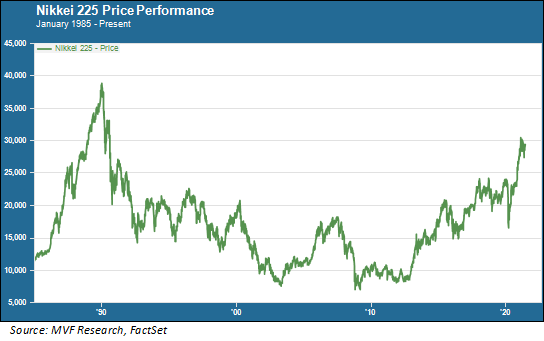
We don’t write much about Japan in our weekly commentaries, because quite honestly in most weeks there are other, more important things going on in global capital markets that we believe merit our attention. Every now and then, however, a story catches our eye and reminds us that there is always a valuable lesson to be had in considering the case of Japanese equities.
That lesson, quite simply, is that “stocks always go up in the long run” is not a universal law on par with gravity or Schrödinger’s wave function. To this very day the Nikkei 225, which you can think of as Japan’s version of the S&P 500, languishes some 25 percent below its all-time high reached at the end of 1989. You read that right – 1989. Japanese equities hit an all-time high years before anyone in the world even knew who Britney Spears was. Here’s the chart as proof.

The story that caught our attention this week concerns Toshiba, one of the bluest of Japanese blue chips with a 145 year history and a sad reminder of some of the underlying structural problems that help explain the country’s woeful long-term equity price performance.
April Showers Bring No Flowers
Back in April two things happened of note: the Nikkei 225 crossed the 30,000 level for the first time since 1990 (see chart above) and Toshiba chief executive officer Nobutaki Kurumatani abruptly resigned from office. Long-suffering Japanese investors cheered the Nikkei news, but the Toshiba developments suggested how fragile the recent bullish sentiment might be. Kurumatani’s resignation came after a series of long-festering scandals surrounding the company starting with the discovery of widespread accounting fraud in 2015. Two years later its US nuclear business collapsed, leading the company to the edge of bankruptcy. A $5.4 billion emergency equity infusion rescued the company, deemed by Japanese regulators to be of the highest strategic importance. But Toshiba continued to flounder, selling off valuable assets like its semiconductor chip business in efforts to stay afloat.
Barbarians At The Gate
That $5.4 billion equity infusion was no free lunch for Toshiba, and it set the stage for the extraordinary set of events that happened this week, leading to the decision today at the annual general meeting of shareholders to oust the chairman of the board Osamu Nagayama, a longstanding pillar of Japan’s corporate establishment. The 2017 equity infusion brought a bevy of foreign institutional shareholders into the company, including a number of activist investors who pushed for increased transparency and better governance to clean up the company’s image tarnished by its earlier scandals.
An explosive independent report issued recently detailed the extent to which Toshiba and one of its key government regulators, the Ministry of Economy, Trade and Industry (METI), colluded on measures to suppress activist shareholders. For many shareholders, activist or not, the report revealed just how little has changed in “Japan, Inc.” in terms of shoddy governance, improper regulatory protection and practices designed to entrench the status quo. The independent report that preceded today’s AGM could just as well have been written in the 1980s, back when METI was the formidable institution then known as MITI (Ministry of International Trade and Industry), the scourge of foreign competitors trying to break into the Japanese market.
Lessons Learned, Or Not
The ironic twist to the Toshiba story is that its next incarnation may well be on the auction block for sale to private equity bidders. One such attempt, by private equity firm CVC, failed in April (and directly led to the resignation of then-CEO Kurumatani). That bid, though, appears to have paved the way for other foreign firms to compete for the prize – such as it is – of one of the most high-profile Japanese firms ever. Such an end would be a major blow to the Tokyo Stock Exchange, and more broadly to the image of better business practices that former Japanese prime minister Shinzo Abe touted as one of the key pillars of his “Abenomics” program.
Whether anyone has actually learned a useful lesson here remains to be seen. There is much chatter this week about l’affaire Toshiba being the wake-up call Japan needs to justify a sustained improvement in its economic and market fortunes. Yes, but there have been many wake-up calls before, both before and after the Nikkei 225 peaked around 39,000 on December 31, 1989. For the time being, that Nikkei 30,000 level breached in April still seems awfully fragile.